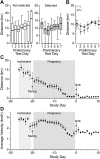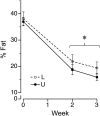Maternal exercise during pregnancy promotes physical activity in adult offspring
- PMID: 27033262
- PMCID: PMC4904289
- DOI: 10.1096/fj.201500018R
Maternal exercise during pregnancy promotes physical activity in adult offspring
Abstract
Previous rodent studies have shown that maternal voluntary exercise during pregnancy leads to metabolic changes in adult offspring. We set out to test whether maternal voluntary exercise during pregnancy also induces persistent changes in voluntary physical activity in the offspring. Adult C57BL/6J female mice were randomly assigned to be caged with an unlocked (U) or locked (L) running wheel before and during pregnancy. Maternal running behavior was monitored during pregnancy, and body weight, body composition, food intake, energy expenditure, total cage activity, and running wheel activity were measured in the offspring at various ages. U offspring were slightly heavier at birth, but no group differences in body weight or composition were observed at later ages (when mice were caged without access to running wheels). Consistent with our hypothesis, U offspring were more physically active as adults. This effect was observed earlier in female offspring (at sexual maturation). Remarkably, at 300 d of age, U females achieved greater fat loss in response to a 3-wk voluntary exercise program. Our findings show for the first time that maternal physical activity during pregnancy affects the offspring's lifelong propensity for physical activity and may have important implications for combating the worldwide epidemic of physical inactivity and obesity.-Eclarinal, J. D., Zhu, S., Baker, M. S., Piyarathna, D. B., Coarfa, C., Fiorotto, M. L., Waterland, R. A. Maternal exercise during pregnancy promotes physical activity in adult offspring.
Keywords: activity-stat; developmental programming; metabolic imprinting.
© FASEB.
Figures





References
-
- Atkinson R. L., Pietrobelli A., Uauy R., Macdonald I. A. (2012) Are we attacking the wrong targets in the fight against obesity? The importance of intervention in women of childbearing age. Int. J. Obes. 36, 1259–1260 - PubMed
-
- Gluckman P. D., Hanson M. A. (2004) Developmental origins of disease paradigm: a mechanistic and evolutionary perspective. Pediatr. Res. 56, 311–317 - PubMed
-
- Vickers M. H. (2014) Developmental programming and transgenerational transmission of obesity. Ann. Nutr. Metab. 64(Suppl 1), 26–34 - PubMed
-
- Aiken C. E., Ozanne S. E. (2014) Transgenerational developmental programming. Hum. Reprod. Update 20, 63–75 - PubMed
-
- Gluckman P. D., Hanson M., Zimmet P., Forrester T. (2011) Losing the war against obesity: the need for a developmental perspective. Sci. Transl. Med. 3, 93cm19 - PubMed
Publication types
MeSH terms
Grants and funding
LinkOut - more resources
Full Text Sources
Other Literature Sources

